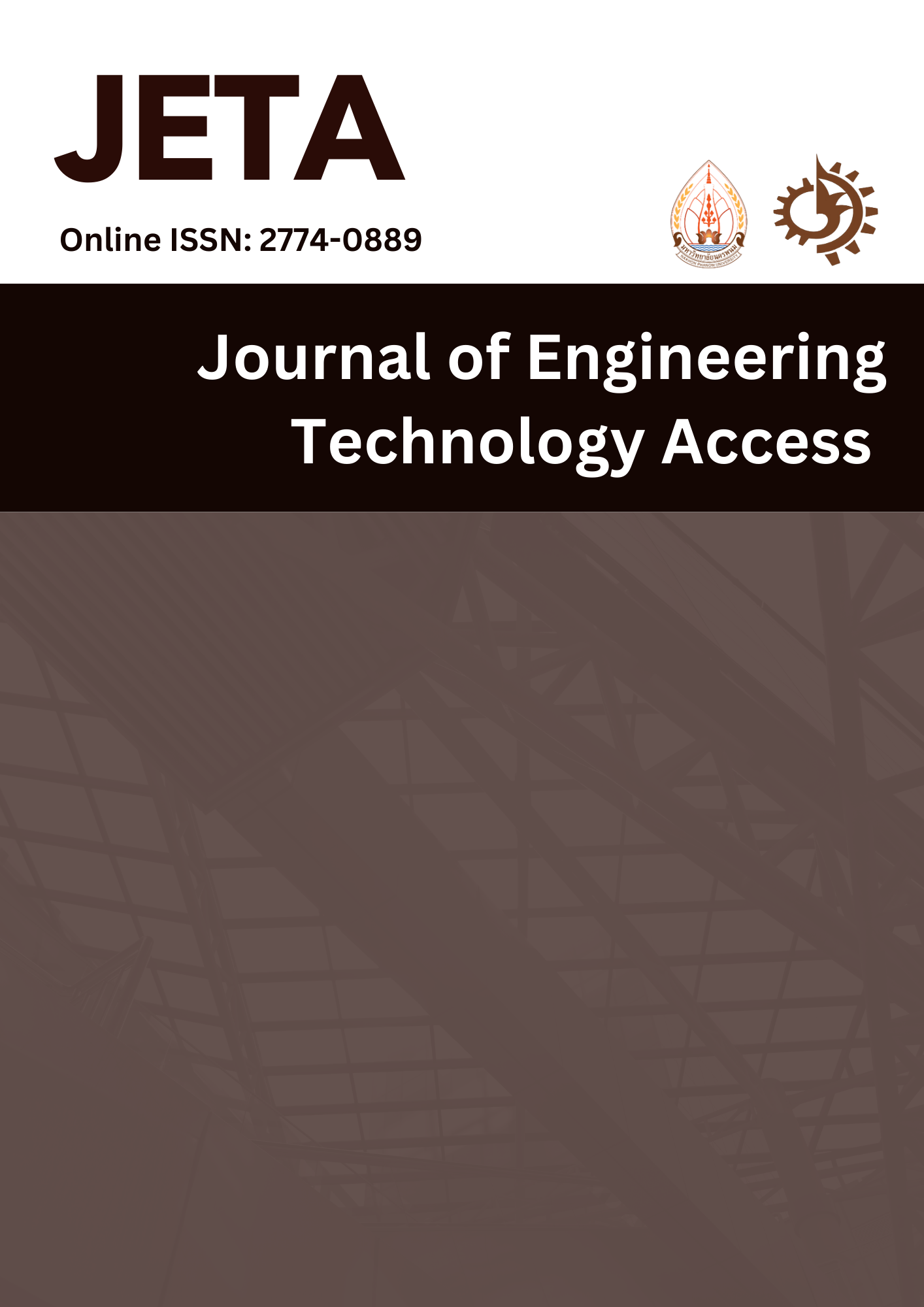การหาสภาวะที่เหมาะสมของกระบวนการกดขัดผิวเรียบอลูมิเนียมผสม AA6061-T6 ด้วยวิธีพื้นผิวตอบสนอง
Main Article Content
บทคัดย่อ
ปัจจุบันมีการพัฒนากระบวนการกดขัดผิวเรียบวัสดุอลูมิเนียมผสม เพื่อลดเวลาในขั้นตอนการผลิต และการปรับปรุงตกแต่งผิววัสดุ การวิจัยนี้ทำการศึกษาสภาวะที่เหมาะสมของกระบวนการกดขัดผิวเรียบอลูมิเนียมผสม เกรด AA6061-T6 โดยใช้เครื่องกลึงซีเอ็นซี(CNC lathe machine) ส่งผลต่อค่าความต้านทานแรงดึงที่เหมาะสมของกระบวนการผลิตแบบกดขัดผิวเรียบจากการทดลองพบว่า ปัจจัยในกระบวนการขัดผิวเรียบอลูมิเนียมผสม เกรด AA6061-T6 ที่เหมาะสม ที่ความเร็วรอบ 200 รอบ/นาที อัตราป้อน 0.2571 เมตร/นาที และอัตราป้อนลึก 0.09 มิลลิเมตร โดยให้ค่าความต้านทานแรงดึงสูงสุด 370 MPa และมีค่าความแข็งสูงสุดที่ ความเร็วรอบ 393 รอบ/นาที อัตราป้อน 0.3258 เมตร/นาที และอัตราป้อนลึก 0.090 มิลลิเมตร การตรวจสอบโครงสร้างจุลภาคของชิ้นงานที่ทำการกดขัดผิวเรียบ พบว่า ปัจจัยต่าง ๆ ในกระบวนการ ไม่ส่งผลต่อโครงสร้างที่มีการเสียหายแต่อย่างใด ทำให้กระบวนการกดขัดผิวเรียบเหล่านี้ เป็นกระบวนการ ที่เหมาะสมและมีประสิทธิภาพในการผลิตชิ้นงานวัสดุอลูมิเนียมผสม AA6061-T6 และลดเวลาในการผลิตลง ได้อย่างมีประสิทธิภาพ
Article Details

อนุญาตภายใต้เงื่อนไข Creative Commons Attribution-NonCommercial-NoDerivatives 4.0 International License.
เอกสารอ้างอิง
Ozer, M., Dalli, K., & Ozer, A. (2023). Effect of ball-burnishing on surface integrity and fatigue behaviour of 7175-T6 AA. Materials Science and Technology, 39(2), 248-257.
Saffar, S., & Eslami, H. (2022). Increasing the fatigue life and surface improvement of AL7075 alloy T6 by using ultrasonic ball burnishing process. International Journal of Surface Science and Engineering, 16(3), 181-206.
Suriya Prasomthong, & Suriya Namkaew, (April, 2021). Application of Taguchi Method for Burnishing Process of AA5052 Aluminum Alloy by Studying the Optimization of Production Machining Parameters.
H. Yilmaz and R. Sadeler, Effect of ball burnishing treatment on the fatigue behavior of 316L stainless steel operating under anodic and cathodic polarization potentials.Metallurgical and Materials Transactions A, 2018, 49(11), 5393-5401.
A. Sova, C. Courbon, F. Valiorgue, J., Rech, and Ph. Bertrand, Effect of turning and ball burnishing on the microstructure and residual stress distribution in stainless steel cold spray deposits. Journal of Thermal Spray Technology, 2017, 26(8), 1922-1934.
Raza, A., & Kumar, S. (2022). A critical review of tool design in burnishing process. Tribology International, 174, 107717.
Diekmann, James E., & Nelson, Mark C. (1985). Construction Claims: Frequency and Severity. Journal of Management in Engineering, 111(1), 74-81.
Ekakul, T. (2000). Research Methods in Behavioral Science and Social Science. (8th edition). Chulalongkorn University, Bangkok, Thailand.
K. Hinkelmann and O. Kempthorne, Design and analysis of experiments, Volume 1:
Introduction to experimental design 1st ED., John Wiley and Sons, Inc., NY, USA, 1994
Prasomthong, S., & Charoenrat, S. (2022). The The optimization of welding hardfacing on wear resistance of FC-25 grey cast iron steel substrate by response surface methodology (RSM). SNRU Journal of Science and Technology, 14(2), 245154-245154.
Charoenrat, S., Pookamnerd, Y., & Prasomthong, S. (2021). การพิจารณาสภาวะที่เหมาะสมในการเชื่อมพอกผิวต่อการต้านทาน การสึกหรอด้วยกระบวนการเชื่อมแก๊สทังสเตนอาร์คแบบลวดร้อนโดยวิธีพื้นผิวตอบสนอง. The Journal of Industrial Technology, 17(2), 87-102.
K.Hinkelmann and O. Kempthorne, Design and analysis of experiments, Volume 1: Introduction to experimental design 1st ED., John Wiley and Sons, Inc., NY, USA, 1994






